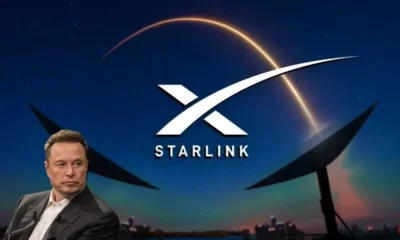Trends
The Battle For Space Supremacy, Jeff Bezos’ Blue Origin Gears Up For A New Glenn Liftoff. What Are The Bets, Can Blue Origin Catch Up?
Published
1 month agoon

Move over, SpaceX. Jeff Bezos and his rocket-building venture, Blue Origin, are making a power move in the race for space supremacy. Nearly 25 years after its inception, Blue Origin is set to launch its first orbital rocket, the New Glenn, in what could be a game-changing moment for the Bezos-backed company.
New Glenn. Ready for Liftoff
Named after John Glenn, the first American astronaut to orbit Earth, the New Glenn rocket is a beast. At 320 feet tall, it dwarfs most of its competitors and is classified as a heavy-lift vehicle. With more than twice the power of SpaceX’s workhorse Falcon 9, this rocket is not only big; it’s ambitious.
The maiden flight, now rescheduled for Monday at 1 a.m. ET due to sea conditions, will launch from Cape Canaveral Space Force Station in Florida. The goal is to put a Blue Origin test satellite, the Blue Ring Pathfinder, into orbit and safely land the rocket’s lower portion on a drone ship in the Atlantic.
If successful, this launch could catapult Blue Origin into an elite group of U.S. companies capable of sending satellites to orbit, marking a major milestone for a company that has so far lagged behind SpaceX in the space race.
Why the Race for Space?
Space isn’t just the final frontier; it’s big business. Bezos has long touted his vision for making space more accessible and using it to preserve Earth. “We need to lower the cost of access to space,” he said at the NYT Dealbook Summit. So what is he aiming for? Moving polluting industries off the planet and transforming Earth into a pristine haven.
But dreams need rockets—and results. While Blue Origin has dabbled in suborbital tourism (remember those celebrity joyrides to the edge of space?), it has yet to make a dent in the lucrative satellite launch market dominated by SpaceX. With New Glenn, Bezos hopes to change that story and finally put a dent in SpaceX’s near-monopoly.
The SpaceX Shadow
Speaking of SpaceX, it’s impossible to talk about Blue Origin without mentioning Elon Musk’s space juggernaut. Both companies were founded around the same time, but their trajectories couldn’t be more different.
While SpaceX’s Falcon 9 rockets have become the gold standard for orbital launches, completing more than 270 successful missions, Blue Origin has struggled to move beyond its initial ambitions. A successful New Glenn launch could finally give Blue Origin the momentum it needs to catch up.
But catching up won’t be easy. SpaceX isn’t just ahead; it’s light-years ahead. From Starlink satellites to crewed missions, Musk’s company has redefined the commercial space industry. Blue Origin’s success with New Glenn would be a step in the right direction, but it’s just the beginning of a much longer journey.

What’s Next for Blue Origin?
If New Glenn lives up to its promise, the rocket will help Blue Origin clear a $10 billion backlog in customer contracts, including launching payloads for NASA and private clients. Looking further ahead, the company plans to use New Glenn for moon missions and even Bezos’ ambitious vision of moving industries off Earth.
For Bezos, this isn’t not only about catching up to Musk; it’s about cementing Blue Origin’s place in the future of space exploration. Whether that means establishing lunar bases, launching industries into orbit, or simply competing in the commercial launch market, New Glenn is the key to it all.
What to Watch For
Here’s how the New Glenn’s maiden voyage is expected to unfold, assuming everything goes according to plan:
The Big Start: The rocket’s first-stage booster, powered by seven BE-4 engines, will roar to life, delivering the thrust needed to break free from Earth’s grip. This booster is the largest and most critical part of the rocket for liftoff.
Booster Detachment: A few minutes after launch, once most of the fuel is spent, the booster will separate from the upper stage, which includes the payload fairing—the nose cone designed to protect cargo during liftoff.
The Booster’s Return: Here’s where it gets fancy. The booster, equipped with fins and strakes (think winglike stabilizers), will guide itself back to a recovery platform in the Atlantic Ocean named Jacklyn (a tribute to Bezos’ mom). As it nears the platform, the booster will reignite some of its engines and deploy six massive legs for a soft landing. This reusable booster strategy, inspired by SpaceX’s playbook, aims to cut costs and make launches more sustainable.
Up to Orbit: Meanwhile, the rocket’s upper stage, carrying the Blue Ring Pathfinder experiment, will press on. Two space-optimized engines will fire up, pushing the vehicle to orbital speeds—about 17,500 mph, or 23 times the speed of sound.
No Satellite Deployment: Unlike typical satellite launches, this mission is all about testing. The Blue Ring Pathfinder payload will stay attached to the upper stage for the entire six-hour mission, serving as a demonstration for future flights.
The Big Bets
Let’s not sugarcoat it: this is a litmus test, and success is far from guaranteed.
Critical Engine Test: Blue Origin’s BE-4 engines, which have only been fired together for 24 seconds during a ground test in December, need to sustain burn for much longer to power the rocket into orbit.
Room for Error: At any point, something could go wrong—whether it’s engine trouble, a botched booster landing, or an issue with the upper stage. A single failure could spell disaster for this much-anticipated mission.
But if Blue Origin pulls it off, the launch could mark a key moment for the company, finally positioning it as a serious contender in the space race. For Bezos and his team, its about proving they can compete and about proving they belong.
Space exploration isn’t for the faint of heart, and New Glenn’s maiden voyage could go wrong, if the rocket veers off course, Blue Origin may have to hit the ultimate panic button—a self-destruct command that would reduce the rocket to debris, ensuring it doesn’t endanger people or property.
But let’s focus on what could go right. The primary mission is to deliver the rocket’s second stage and the Blue Ring Pathfinder technology into orbit. If that goal is achieved, it’ll be a massive win for Blue Origin. That said, even if the booster fails to land on the Jacklyn platform, the mission won’t be deemed a failure.
Unlike SpaceX, which has made reusable boosters a cornerstone of its operations, Blue Origin sees booster recovery as a bonus—a cost-saving measure rather than a necessity. Most other rocket builders simply discard that part of the vehicle after launch anyway.
From Small to Mighty
About a decade ago, the buzz in the space industry was all about small, lightweight rockets. The idea was that these nimble vehicles could quickly launch satellites to build massive constellations in low-Earth orbit. But reality had other plans.
“None of the constellation operators went to small rockets,” Henry points out. “They all went to medium- or heavy-lift because getting more up in a single mission is faster and more economical than launching one or two satellites at a time.”
Adding to the mix, those satellites themselves have bulked up over the years, making heavy-lift rockets like New Glenn even more essential.

Two Companies, Two Trajectories
When Jeff Bezos founded Blue Origin in 2000, his dream was ambitious: make space travel as routine as hopping on a flight. He envisioned a future where low-cost launches would unlock a new wave of innovation, creating industries in orbit and beyond.
Fast forward to today, and while Blue Origin has made strides—like suborbital tourism flights—it’s still playing catch-up to SpaceX. Elon Musk’s company has become synonymous with reusable rockets, groundbreaking launches, and audacious plans for Mars.
To understand Blue Origin’s current position, it helps to compare its journey with SpaceX’s. Founded just two years apart—Blue Origin in 2000 and SpaceX in 2002—both companies set out to make space travel cheaper, safer, and eventually routine.
However, their strategies couldn’t have been more different.
SpaceX went all-in from the start, aggressively chasing government contracts and rapidly developing rockets that could fly. Its early partnerships with NASA, especially the high-profile Commercial Crew Program, gave it a major boost.
The Falcon 9 rocket’s vertical landing and reusability were game-changing milestones that slashed costs and revolutionized the industry. By 2020, SpaceX had made history, sending astronauts to the International Space Station aboard its Crew Dragon capsule—the first privately owned spacecraft to achieve such a feat.
Meanwhile, Blue Origin opted for a more cautious route, pouring resources into research and development. Instead of chasing contracts, it focused on perfecting its technology behind the scenes. While SpaceX was making headlines with orbital launches, Blue Origin concentrated on suborbital tourism with its New Shepard rocket.
The Space Tourism Divide
There’s no denying that Blue Origin’s suborbital flights have been headline-grabbing. Jeff Bezos himself took a ride, along with celebrities like William Shatner, offering passengers a few minutes of weightlessness and unforgettable views. But these short hops haven’t pushed the boundaries of space exploration in the same way as SpaceX’s orbital missions.
SpaceX’s Falcon 9 rockets, reusable and reliable, have become the workhorses of the commercial launch market, cementing its reputation as a leader in the industry. Blue Origin, by contrast, is still working to demonstrate its capabilities in orbital launches and heavy-lift missions.
What If Blue Origin Can’t Catch Up?
There is no guarantee Blue Origin will close the gap with SpaceX. The hurdles are formidable. What if the New Glenn rocket underperforms? What if SpaceX continues to push the envelope, leaving Blue Origin struggling to keep pace in both innovation and execution?
One of Blue Origin’s biggest challenges is the entrenched advantage SpaceX has built over the years. SpaceX has established itself as NASA’s go-to partner, thanks to a flawless track record of launching satellites, cargo, and astronauts. Its reusable Falcon 9 rockets have become the gold standard for reliability and cost-efficiency, and the ambitious Starship project promises to take interplanetary travel to the next level.
Blue Origin, by comparison, has yet to achieve such milestones. It’s struggled to meet deadlines, with its flagship New Glenn rocket’s debut delayed multiple times. Originally set to launch years ago, it’s now expected to make its first flight at the end of 2024—assuming there are no further setbacks.
Funding is another area where Blue Origin lags. While Jeff Bezos has personally bankrolled much of the company’s operations, external investment has been modest compared to SpaceX. This could be due, in part, to Bezos’ long-term vision of space colonies, which feels more like science fiction compared to Elon Musk’s immediate focus on Mars colonization and commercial space travel.
The Case for the Tortoise Approach
But what if Blue Origin’s slow-and-steady strategy pays off in the end? Unlike SpaceX’s rapid iteration approach—marked by frequent launches and public failures—Blue Origin has opted for a more cautious path, focusing on refining reusable technology and building a solid operational foundation.
This methodical pace might eventually allow Blue Origin to outlast competitors. Perfecting its technology could lead to greater reliability and cost-effectiveness in the long run, potentially winning over customers who prioritize precision over speed.
Moreover, Bezos’ vast personal fortune ensures that Blue Origin has the financial runway to take its time. While the company may not have the same sense of urgency as SpaceX, it’s also not under the same pressure to deliver immediate results for investors.

The Future of Space Exploration. Is There Room for Both?
The modern space race is no longer a geopolitical contest between nations but a high-stakes rivalry among private enterprises, spearheaded by billionaires with sky-high ambitions. From SpaceX, Blue Origin, and Virgin Galactic to newer entrants like Rocket Lab and legacy aerospace giants like Boeing, the possibilities for transforming humanity’s relationship with space are limitless.
Yet, amidst the fierce competition, a crucial question – Is space big enough for everyone to succeed?
Space exploration has moved beyond moon landings and Mars dreams. The future promises practical applications that could reshape life on Earth and beyond:
—Global Internet Connectivity: Satellite constellations, like SpaceX’s Starlink, aim to provide high-speed internet access to remote areas.
—Asteroid Mining: Companies envision extracting valuable resources like rare metals from asteroids, potentially revolutionizing industries on Earth.
—Human Colonies: Both Elon Musk and Jeff Bezos dream of establishing permanent human settlements, whether on Mars or in orbital habitats.
These ventures require innovation, collaboration, and substantial investment—leaving ample room for multiple players.
The Case for Collaboration
While competition often fuels innovation, the space industry’s scope and complexity suggest a collaborative approach could be even more beneficial. What if these companies pooled resources, knowledge, and expertise to tackle humanity’s most ambitious goals—be it colonizing Mars, creating lunar bases, or building asteroid mining stations?
Each company brings unique strengths to the table. Together, they could accelerate the timeline for making space accessible, not just to governments and billionaires, but to everyday people.
The Last Bit, The Race Is Just Beginning
The battle for space supremacy is heating up, and New Glenn is Blue Origin’s ticket to the fight. Whether it can go toe-to-toe with SpaceX remains to be seen. The next decade will define the trajectory of private space exploration.
For now, we watch, we speculate, and we dream—because when it comes to space, the sky is no longer the limit. As Bezos and Musk duke it out among the stars, one can’t help but wonder—what’s next? Only time (and a few successful launches) will tell.
You may like
-


First No And Now Yes, Ontario Pauses Threat To Musk’s $100M Starlink Deal As Trump Offers Tariff Concessions – Why The EU Wants To Wean Itself Off Musk’s Projects
-


Extortion Or Merely Obliging? From “Jeff Bozo” To “Zuckerschmuck,” Big Tech Titans Are Suddenly Singing A Different Tune For Trump’s Inaugural Fund.
-


Elon Musk’s Vision, Humans On Mars. Can It Be A Reality? Well, At Your Own Risk As It Turns Out!
